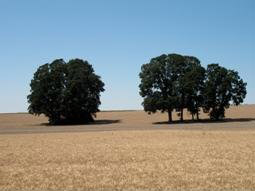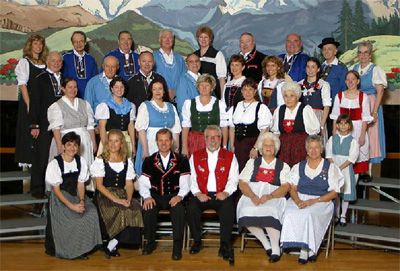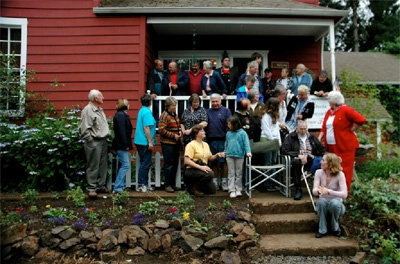 |
||||||||
|
||||||||
Helvetia's Cultural HeritageGreater Helvetia's cultural heritage goes back to the ancient Kalapuyan-Atfalati (Tuality) peoples, now part of the Confederated Tribes of the Grand Ronde. The Grand Ronde recognize Helvetia as part of their cultural heritage and have identified a number of cultural sites in the area. They consider Helvetia a “remnant cultural landscape,” which is an area remaining very similar in flora, fauna, and landscape as it was in previous cultural histories. Pre-Settlement Native AmericansThe area north of Highway 26 served the the Atfalati people in several ways. The Cha-takuin, "place of big trees", is now known as "Five Oaks". The Five Oaks and their historical marker are located just east of Helvetia Road on the south side of Jacobsen Road. It was one of the camping spots the Atfalati used in their seasonal travels from their winter towns surrounding Wapato Lake near Forest Grove to the Tualatin Mountains. During the summers and falls, the Atfalati would camp at Cha-takuin and pick berries and acorns throughout the area north of Highway 26. (13) The Atfalati created trails for traveling from the Tualatin Valley floor over the Tualatin Mountains to the Columbia River. The trails later became present-day NW Logie Trail, NW Bishop Road and NW Cornelius Pass Roads. Residents throughout the 20th century found numerous relics of Native American life along these roads: arrowheads, beads, shells. At least one Cultural Site is located within this area. Its location has been protected by the farmers and its land left undisturbed for the last 150 years.
The historic site of Cowaniah's Battlefield is located on Bishop Road. (2) During the late 1850's, bands of Klickitat Indians from Washington State would cross the Columbia River and raid the Willamette Valley, entering by way of Logie Trail. Local history has it that Charles Cowaniah, an Indian homesteader who resided on what was to become Helvetia Road, organized a group of white and Indian residents to repel the Klickitat invaders. The battle, which occurred in 1860, was brief, but Cowaniah had his horse shot out from beneath him. Old timers say that, as young children, they could see the bones of Cowaniah's horse in the bushes. The surprise encounter with the group of valley residents sent the Klickitats fleeing on horseback over the hills to the Columbia River. The Oregon white oak savannas found throughout the area north of Highway 26 provided shelter and sustenance to the Atfalati. In the fall, the Atfalati would gather acorns that fell from the giant Oregon white oaks, crushing them into a meal, or mush. Swiss-German settlersThe earliest Swiss-German homesteaders began to arrive in the Helvetia area in 1873-1874. Over the next 25 years, more than 70 families arrived from Switzerland and Germany. Today, more than 135 years after the first Swiss German immigrants arrived in Helvetia, the Swiss culture remains a vibrant part of the Portland metropolitan region. Hundreds of descendants of these original Swiss German families continue to honor their Swiss heritage.
Becky Sowders, a yodeler with the Helvetia-Alpengluehn Swiss Singers, observes: “The Swiss Community in Oregon is alive and thriving as the descendants of these early settlers still lay claim to their Swiss heritage. The annual Swiss wrestling contests have been held every summer for the last 92 years. The 120-year-old Helvetia Alpengluehn Singing Society has one of their concerts every fall out on West Union Road. And they have hosted four West Coast Singing and Yodeling festivals - bringing up to a thousand Swiss from Canada to California and beyond to Portland.” In addition, the Swiss Kids Kamp is held annually for children who are the 4th and 5th generation descendants from the early Swiss families from Helvetia. The Helvetia Swiss Festival
|
||||||||
|
Home • About Us • Market • Activities • Donate |
||||||||
| About Helvetia • Directory • Volunteer! • Contact us | ||||||||
|
Web site design and programming by Brian Beinlich
•
Contact the webmaster |









 Some of the original families’ names are found on roads throughout the area: Badertscher, Bishop (originally Bischoff), Dick, Dierdorff, Dorland,
Grossen, Meier, Phillips (for Phillip Pezoldt), Pubols, Solberger, Schaaf, Stadelman, and Yungen.
Some of the original families’ names are found on roads throughout the area: Badertscher, Bishop (originally Bischoff), Dick, Dierdorff, Dorland,
Grossen, Meier, Phillips (for Phillip Pezoldt), Pubols, Solberger, Schaaf, Stadelman, and Yungen.

